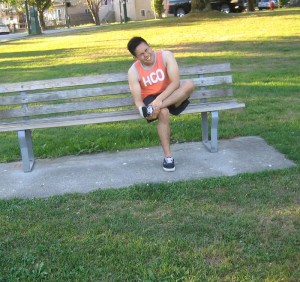Plantar fasciitis is the common cause of heel pain. The condition involves pain and inflammation of a thick band of tissue called the plantar fascia that is found across the bottom of the foot and connects the heel bone to the toes.
Plantar fasciitis causes piercing pain that typically happen with the first step upon waking up in the morning. When the foot strengthens up, the pain caused by plantar fasciitis is minimized, but it can return when standing for prolonged periods of time and after staying in a sitting position. Plantar fasciitis is common among runners. If you want to learn more about the management of this condition, click here.
Causes of plantar fasciitis
Plantar fasciitis can develop as a result of recurrent small-sized tears in the plantar fascia. When walking, the plantar fascia stretches when the foot strikes the ground. When the plantar fascia is strained by ways of walking or repeated stress, it can be weakened or become irritated or inflamed, thus causing pain when standing or walking.

Some activities that can cause plantar fasciitis include the following:
- The irregular internal twisting of the foot or pronation, elevated arches, flat feet and taut calf muscles.
- Jobs that require prolonged walking or standing on hard or irregular surfaces.
- Extra stress on the feet such as being overweight or wearing of shoes that does not properly cushion the feet or does not fit well.
- Susceptible to this condition are the middle-aged adults
- An injury to the foot can cause plantar fasciitis
Symptoms of plantar fasciitis
The first symptoms of plantar fasciitis include pain in the heel when taking the first step after getting out of the bed or when sitting for a long period. Other accompanying symptoms include the following:
- There is pain when climbing the stairs or standing on the toes.
- Pain when standing for a long period of time.
- There is pain when doing some exercises and goes away as exercises continues and returns again when the exercise is finished.
There are factors that increases the risk of having a plantar fasciitis such as people ages 40 to 60, performing exercises that puts a lot of stress on the heel and the attached tissues such as long distance running, dance aerobics and ballet dancing.
Other factors include being flat-footed, high arch or an abnormal pattern of walking can affect the way the weight is distributed when in standing position and adds stress on the plantar fascia. Even obesity can cause stress on the plantar fascia while factory workers and teachers who spends most of their time standing on hard surfaces can cause damage to their plantar fascia.
Treatment and home remedies
- Stop and minimize doing activities that causes the heel pain.
- Wear shoes that have good arch support and good cushioning of the heel
- Apply an ice pack on the heel in helping reduce the inflammation. Taking a bath using hot and cold alternately can also be helpful and end the bath by soaking in cold water.
- Take ibuprofen or anti-inflammatory medications in order to minimize pain and inflammation.
- Wear night splints since it stretches the plantar fascia ligament and prevents them from getting tight during the night.
- Do some exercises in strengthening the muscle of the foot and ankle in order to support the arch.
